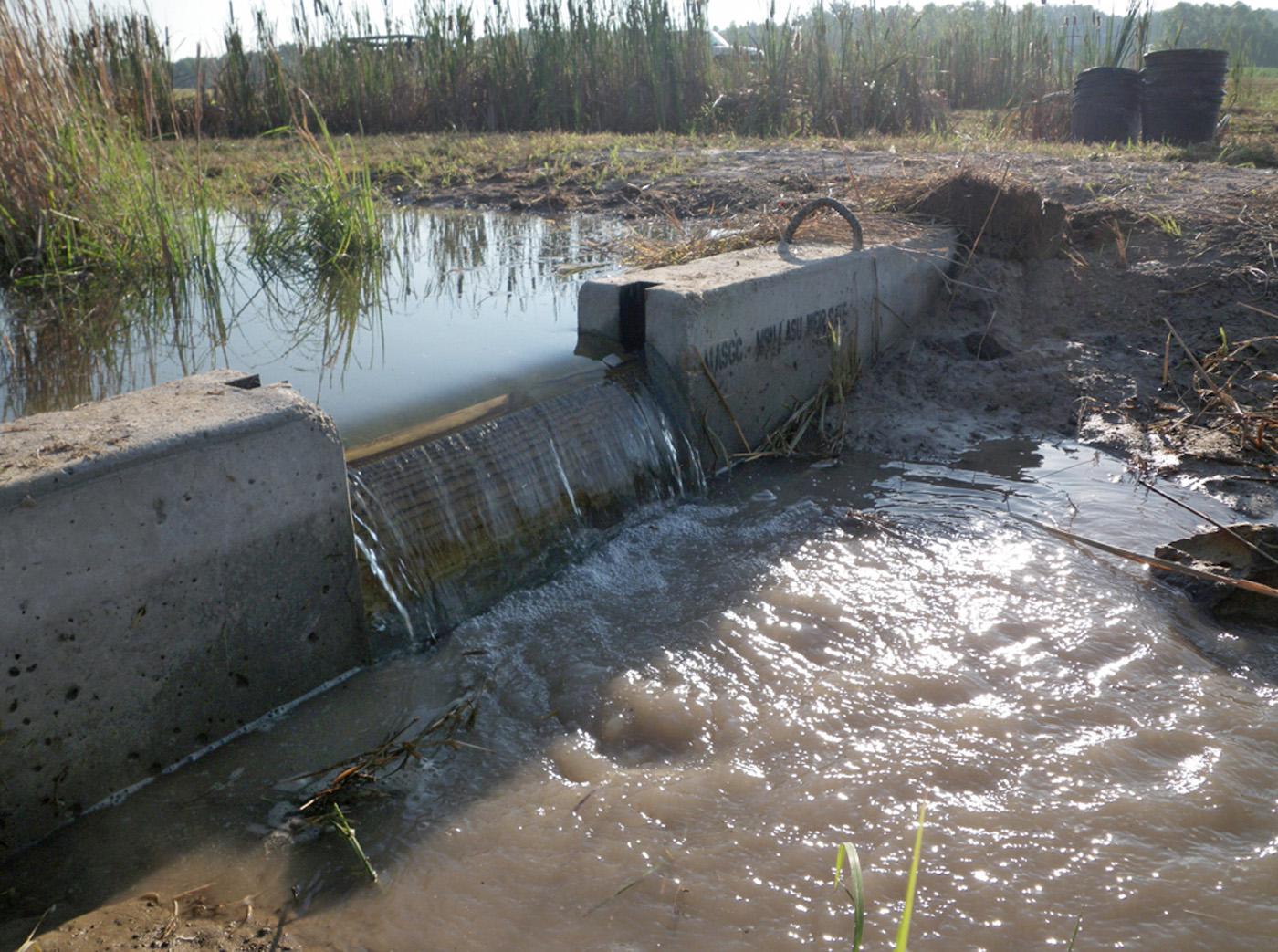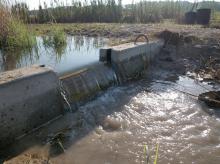Information Possibly Outdated
The information presented on this page was originally released on July 29, 2010. It may not be outdated, but please search our site for more current information. If you plan to quote or reference this information in a publication, please check with the Extension specialist or author before proceeding.
New technique protects downstream waters
MISSISSIPPI STATE – A Mississippi State University study has confirmed the success of a new technique to reduce nutrients in runoff water and protect downstream waters, including the Gulf of Mexico.
Weirs, also known as check dams, are small dams used to collect water runoff from agricultural fields. Weirs are often the size of a drainage ditch, with a 2-foot channel in the center for water drainage. The weirs are concrete can be moved to various locations in a drainage ditch.
“As water from agricultural fields drains, high concentrations of fertilizer nutrients, such as nitrogen and phosphorus, can be carried downstream,” said Robbie Kröger, assistant professor of aquatic sciences in the MSU Department of Wildlife, Fisheries and Aquaculture. “These nutrients promote algal production and microbial decomposition in downstream coastal ecosystems like the Gulf of Mexico, which in turn decreases vital oxygen levels.”
Farmers throughout the Delta have been protecting water quality for years and are now using weirs as a low-cost method to immediately reduce nutrient runoff.
“Drainage ditches on farms filter and alter nutrients before water reaches rivers,” Kröger said. “Weirs can provide numerous locations along the drainage ditch for nutrients to be absorbed and transformed.”
Most agricultural land is drained through a slotted riser that can be boarded to retain water within the drainage ditch. A pipe drains away the water.
“Several weirs can be stair-stepped throughout the drainage ditch to provide maximum nutrient retention,” Kröger said.
Wherever a weir is installed, water collects to form a miniature wetland, which may improve crop yields by adding moisture to the field.
Scientists in the MSU Forest and Wildlife Research Center and Mississippi Agricultural and Forestry Experiment Station are optimistic that the weirs will improve both nutrient retention and irrigation efficiency.
Funded by the Mississippi-Alabama Sea Grant Consortium, the study evaluated the impact of low-grade weirs in an experimental design.
“Our objective was to compare weired and slotted-pipe systems for nutrient reduction during simulated storm runoff events,” Kröger said.
Results indicated that the weirs removed contaminants effectively. Weirs and outlets alone, however, cannot reduce nutrients. Vegetation is needed to absorb and retain nutrients.
A new project funded by the Environmental Protection Agency’s Gulf of Mexico Program Office is evaluating how weirs, slotted pipes and vegetation drainage ditches contribute to overall watershed nutrient reductions.
“Mississippi is one of the first states to implement vegetative drainage in agricultural ditches as part of the USDA’s Natural Resources Conservation Service’s Environmental Quality Incentives Program,” Kröger said.
EQIP offers financial and technical assistance to participants who install or implement structural and management practices on eligible agricultural land.
“Mississippi’s history with EQIP and the experimental research done on weirs have positioned the university well,” Kröger said. “We need to understand how all these structures interact in the field, at the watershed or farm scale to assess their overall impact on downstream water quality.”
Kröger, the university’s only certified professional wetland scientist, is not alone in his efforts to improve downstream water quality in rivers and streams. The research is a collaborative effort between the Mississippi Department of Environmental Quality, Yazoo Mississippi Delta Joint Water Management District, Delta Farmers Advocating Resource Management, USDA Agricultural Research Service, U.S. Geological Survey (USGS) and U.S. Army Corps of Engineers.
The purpose of the research is to reduce concentrations of local nutrients before they reach the Gulf of Mexico. Scientists are attempting to better understand how nitrogen and phosphorus move through streams to the Mississippi River and then to the Gulf of Mexico. Excessive nutrient loads may result in an overall decline in the coastal economy.
“Mississippi is a leader among Gulf Coast states in developing and implementing nutrient reduction strategies to protect the Gulf of Mexico,” said Richard Rebich, USGS research scientist. “As a result, Mississippi’s Yazoo River Basin contributes less than 6 percent of the overall nutrient load to the Mississippi River,”
Kröger emphasized the need to stay focused on protecting inland and coastal waters, especially in the wake of the Deep Horizon oil spill in the Gulf.
“Landscape stewardship, improving water quality and improving downstream aquatic ecosystem health will help in the oil spill clean-up efforts,” Kröger said. “A healthy river pushes the oil seaward, keeping it at bay and protecting the marshes, estuaries and spawning grounds for fisheries, which will aid in the restoration of the Gulf Coast.”





